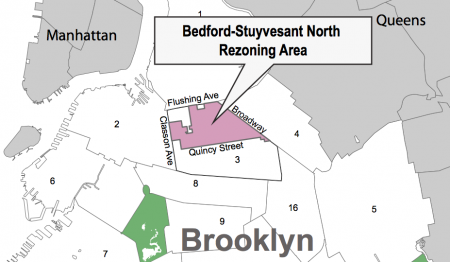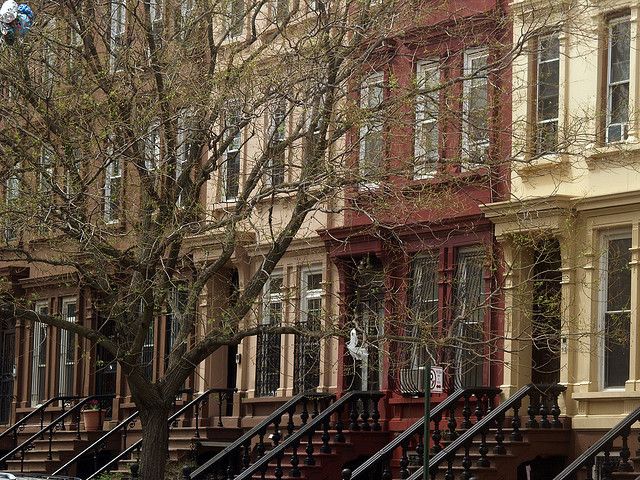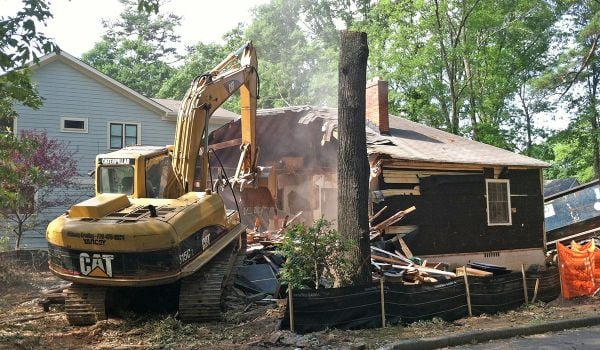This is the third in a series of five interviews with staffers at the New York City Department of City Planning, where the interviewer interned while pursuing a master’s degree in urban planning. Read the first two installments here and here.
Known for its historic brownstones and rich past as a center for African-American culture, Brooklyn’s Bedford Stuyvesant has fast become one of the city’s hippest addresses in recent years, inciting all of the worries and wonder that often accompany tales of gentrification.
To help manage the neighborhood’s growth, the New York City Department of City Planning (DCP) rezoned about 200 blocks of the area’s southern portion in 2007, and is currently shepherding a second rezoning affecting about 140 blocks of its northern half through the public review process.
Here, Anna Slatinsky, a team leader with DCP’s Brooklyn office, discusses what the effort promises for those who live and work in Bed-Stuy.
Next American City: How did this latest rezoning come about?
Anna Slatinsky: City Planning has been working with the neighborhood for several years now about their concerns — things like the scale of development, affordable housing, access to retail goods and services. The community started creating a 197-a plan, which is a formal plan that’s approved by the City Planning Commission and the City Council. But all it does is memorialize the community’s desires for a neighborhood. It doesn’t actually change any regulations.
It became clear that a zoning change would address the community concerns directly and would be a better use of everyone’s time than completing the 197-a process. So the Bedford Stuyvesant South rezoning was the first installment, and now we’re following up with the northern part of the neighborhood.

Credit: DCP
NAC: In what ways do the rezonings target the concerns you mentioned?
Slatinsky: These are contextual rezonings that seek to better reflect the character of the area. The zoning that had been in place, for the most part since 1961, wasn’t a very good fit. It didn’t reflect the area’s three to four-story brownstone row house character very well, because it allowed for 12 to 14-story apartment buildings. So the 2007 rezoning in the south and the current proposal both establish height limits for buildings that are much more consistent with the existing built character.
NAC: Is it an aesthetic motivation to cap building heights? Or what is the broader thinking behind a contextual rezoning?
Slatinsky: Well, it’s all relative. What seems like a tall building in Bedford Stuyvesant wouldn’t feel like one in midtown Manhattan. We typically wouldn’t tag an area characterized by three or four-story buildings for a lot of growth. But it’s another story in places where there are wide streets and commercial corridors that are well served by transit and where larger apartment buildings already exists. The zoning we put in place throughout the city reflects these differences in scale.
NAC: What about the other community issues you mentioned? How are they being addressed?
Slatinsky: The current proposal also creates an Enhanced Commercial District along Broadway. It seeks to enliven the street by requiring generously sized windows and active uses on the ground floor. Another community priority is affordable housing, and we’ve actually seen the development of a couple of significant affordable housing buildings on Fulton Street as a result of the 2007 rezoning.
NAC: Could you say more about how the 2007 rezoning encouraged affordable development?
Slatinsky: City Planning has a tool to incentivize the creation of affordable housing called the Inclusionary Housing Program. It establishes specific areas where developers can get a bonus for creating affordable units. So, within those areas, developers can build slightly larger buildings in proportion to the number of affordable units they create.
NAC: The Brooklyn Bureau reported in December about the scarcity of jobs in Bedford Stuyvesant. Does the proposed rezoning have the potential to improve the employment picture?
Slatinsky: This rezoning aims to set the stage for healthy commercial corridors. For example, Myrtle Avenue and Broadway are major commercial areas that could use a little support. But Bedford Stuyvesant is primarily a residential neighborhood, and it has been historically, so residents will continue to seek employment in Manhattan, downtown Brooklyn, and other areas in the region.
NAC: The 2010 Census showed that, over the last decade, the area has experienced some dramatic population changes, including an influx of new residents and significant shifts in racial composition. Is there a connection to make between the 2007 rezoning and any of these larger neighborhood dynamics?
Slatinsky: The majority of this area has actually had the same zoning since 1961, so I don’t see a big causal relationship. The advantage to the new zoning though is that, in addition to the contextual limits that affect the height and scale of buildings, we can also put in place the affordable housing incentives, which can help shape the neighborhood as time goes on by making sure developers have good reason to include housing for everyone.
Bridget Moriarity is a journalist based in New York City. Her writing has been published in Travel + Leisure and Art + Auction, where she also worked as an editor, as well as in Time Out New York, I.D., Modern Painters and Sotheby’s at Auction.
















